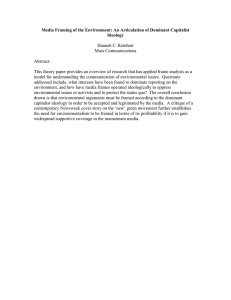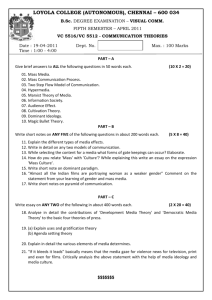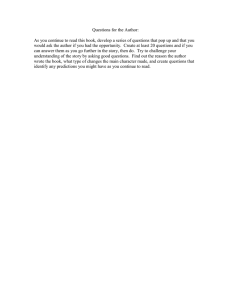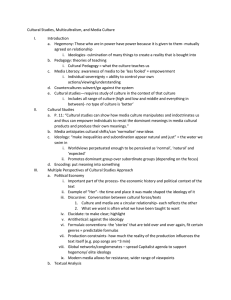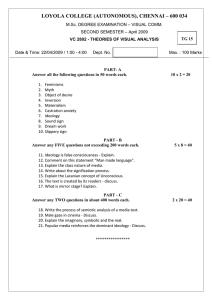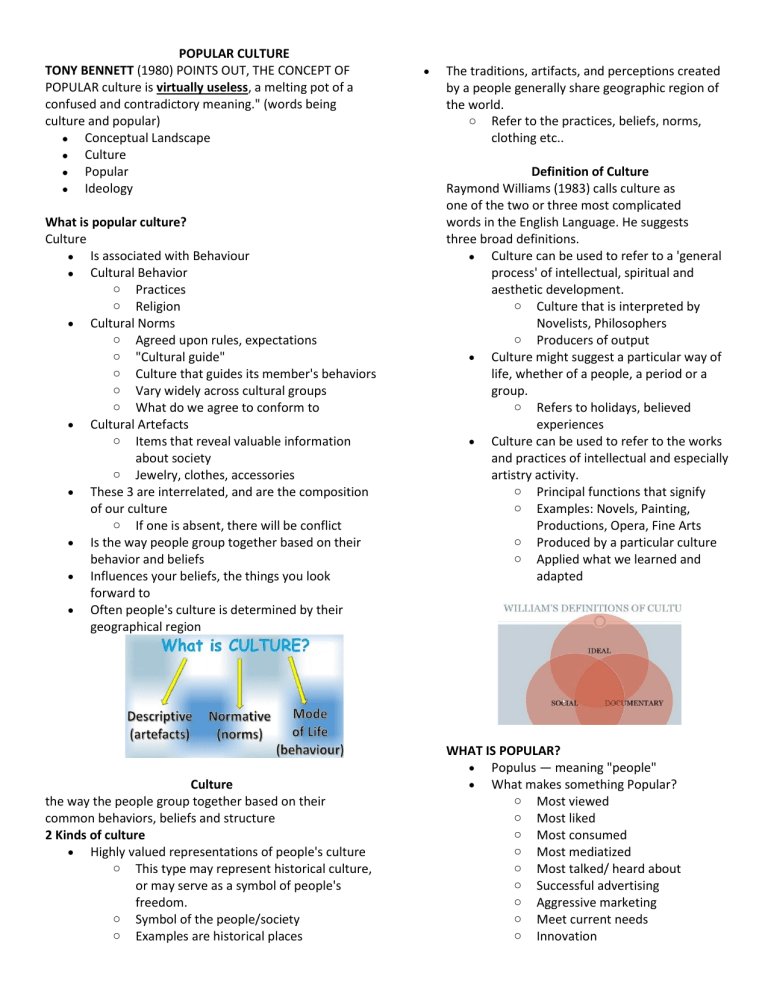
POPULAR CULTURE TONY BENNETT (1980) POINTS OUT, THE CONCEPT OF POPULAR culture is virtually useless, a melting pot of a confused and contradictory meaning." (words being culture and popular) • Conceptual Landscape • Culture • Popular • Ideology What is popular culture? Culture • Is associated with Behaviour • Cultural Behavior o Practices o Religion • Cultural Norms o Agreed upon rules, expectations o "Cultural guide" o Culture that guides its member's behaviors o Vary widely across cultural groups o What do we agree to conform to • Cultural Artefacts o Items that reveal valuable information about society o Jewelry, clothes, accessories • These 3 are interrelated, and are the composition of our culture o If one is absent, there will be conflict • Is the way people group together based on their behavior and beliefs • Influences your beliefs, the things you look forward to • Often people's culture is determined by their geographical region Culture the way the people group together based on their common behaviors, beliefs and structure 2 Kinds of culture • Highly valued representations of people's culture o This type may represent historical culture, or may serve as a symbol of people's freedom. o Symbol of the people/society o Examples are historical places • The traditions, artifacts, and perceptions created by a people generally share geographic region of the world. o Refer to the practices, beliefs, norms, clothing etc.. Definition of Culture Raymond Williams (1983) calls culture as one of the two or three most complicated words in the English Language. He suggests three broad definitions. • Culture can be used to refer to a 'general process' of intellectual, spiritual and aesthetic development. o Culture that is interpreted by Novelists, Philosophers o Producers of output • Culture might suggest a particular way of life, whether of a people, a period or a group. o Refers to holidays, believed experiences • Culture can be used to refer to the works and practices of intellectual and especially artistry activity. o Principal functions that signify o Examples: Novels, Painting, Productions, Opera, Fine Arts o Produced by a particular culture o Applied what we learned and adapted WHAT IS POPULAR? • Populus — meaning "people" • What makes something Popular? o Most viewed o Most liked o Most consumed o Most mediatized o Most talked/ heard about o Successful advertising o Aggressive marketing o Meet current needs o Innovation o Collective consciousness • 3 kinds of Popular o Inferior due to its availability • Popular materials that are seen inferior since they are available everywhere • 'Available ka lagi, pero nawawala na halaga mo' • Popular and mass produced • Example is plastic • Factors supply and demand o Intentionally seeking attention • Popularity Secrets • Idea that something is trying to get people's attention • Content Creation • To catch attention to become viral o Liked by a lot of people • Natural Popularity • Example: Popular books, popular movies, songs, festival all due to its quality and successful advertising • May contain unique characteristics that people love What is popular culture? • Important for everyday people • Culture meant for the general people "pang-masa" • Intended for the people's taste and understanding • There are media that are good in quality but aren't popular due to not acclimating to people's taste • Predominates everywhere What is popular culture (other definitions) • Pop culture is recognized as the people's vernacular or people's culture that predominates in a society at a point in time. • Popular culture involves the aspects of social life most actively involved in by the public. o Large population loved the material o Large population attended that festival • Popular culture encompasses the most Immediate and contemporary aspects of our lives. These aspects are often subject to rapid change, especially in a highly technological world in which people are brought closer and closer by omnipresent media. o We have "Fleeting moment of popularity" for most trends o We keep up, so we can feel a sense of belongingness • We want to be involved • Popular culture maybe defined as the products and forms of expression and identity that are frequently encountered or widely accepted, commonly liked or approved characteristic of society at a given time. • A culture that is intended to represent the common and everyday experiences of the people • • • • • • • Pop culture refers to the systems and practices used by the majority classes in a society Popular culture serves as an inclusionary role in society as it unites the masses on ideals of acceptable forms of behavior. Popular culture reflects the current norms and values of society. This shapes our perceptions of particular groups, places, and lifestyles. Pop culture is defined as " the common images, traditions, customs, and knowledge shared by large groups of people" Popular culture is " culture of the people" Popular culture is " culture of the masses" SIX DEFINITIONS OF POPULAR CULTURE Fifth Edition Cultural Theory and Popular Culture An Introduction John Storey 1. "Popular culture is simply culture that is widely favored or well-liked by many people." • quantitative index would meet the approval of many people • Figures or audience referenced • Ratings, viewers • Must Include the Quantitative Dimension • Demand the figures, demand the quantitative result • Quantitative index is not enough to define popular culture. • By this definition, High culture can also be considered as Popular culture. • Classic Films, Shows, Music • 2. “Popular culture it is the culture that is left over after high culture has been decided.” • Popular culture is a residual category • Inferior Culture • Popular Culture is a mass produced commercial culture • Examples of High culture: Museums, Ballets, Operas, Orchestra, Plays • High Culture has to be difficult • Its difficulty excludes and is exclusive • Is a result of individual creation • Only deserves amoral and aesthetic response • Requires intellectual response • Culture that fails to meet the standards of High culture • • • • • • • Popular Press - Tulfo Quality Press - CNN PH Popular Cinema Art Cinema - Theater plays Popular Entertainment Telenovela Art - Museum • 3. “Popular culture is as ‘mass culture’.” • Popular culture is a hopelessly commercial culture. • It is mass produced for mass consumption. • Its audience is a mass of nondiscriminating consumers. • Passive Consumers • No analysis of products • Can be considered as Forced Consumption The culture itself formulaic, • manipulative • Cultural Fetishism/Commoditized fetishism • It is a culture that is consumed with brain-numbed and brainnumbing passivity. • Mass Culture Perspective • Usually takes one of two forms ▪ A lost organic community ▪ A lost folk culture • Fiske (1989a) points out, 'In capitalist societies there is no so- called authentic folk culture against which to measure the "inauthenticity" of mass culture, so bemoaning the loss of the authentic is a fruitless exercise in romantic nostalgia' • Authenticity of Original Culture is lost • Imposed by capitalist • Commercial Culture for Passivity 4. “Popular culture is the culture that originates from ‘the people’.” • The term should only be used to indicate an "authentic' culture' of the 'people' • This is a popular culture as folk culture: a culture of the people for the people. • Often equated with a highly romanticized concept of working class culture construed as the major source of symbolic protest within contemporary capitalism. • Romanticized concept where pop culture comes from the working class • Takes issue with the word "imposed" • • • • • • • • One problem is Who qualifies in the inclusion of 'the people' • Raw materials are from the people but they don’t produce/complete the product • Originates from the people, may refer to working people 5. "Popular culture is defined based on the political concept of hegemony by Italian Marxist Antonio Gramsci. Gramsci (2009) uses the term 'hegemony' to refer to the way in which dominant groups in society, through a process of 'intellectual and moral leadership' seek to win the consent of subordinate groups in society." • Popular people influencing products • Capitalist seek to use popular people (dominant groups) to encourage popularity/promote products • Usage of Artists in political campaign • Those who are using this approach see popular culture as a site of struggle between the "resistance' if subordinate groups and the forces of ' incorporation' • operating in the interests of dominant groups." Popular culture in this usage is not imposed culture of the mass culture theorists, nor is it an emerging from below, spontaneously oppositional culture of the 'people'. It is a terrain of the exchange and negotiation between the two: • a terrain, marked by resistance and incorporation. The text and practices of popular culture move within what Gramsci ( 1971) calls a "compromise equilibrium". The process is historical (labeled popular culture one moment, and another kind of culture the next) , but it is also synchronic (moving between resistance and incorporation at any given historical moment). In general terms, those looking at popular culture from the perspective of hegemony theory tend to see it as a terrain of ideological struggle between dominant and subordinate classes, dominant and subordinate cultures. As Bennett (2009) explains, The field of popular culture is structured by the attempt of the ruling class to win hegemony and by forms of opposition to this endeavor. As such, it consists not simply of an imposed mass culture that is coincident with dominant ideology, nor simply of spontaneously oppositional cultures, but is rather an area of negotiation between the two within which — in different particular types of popular culture — dominant, subordinate and oppositional cultural and ideological values and elements are 'mixed' in different permutations (96). "Kung sino mas mataas, sila ang nasusunod" • 6. “Popular culture based on postmodernism.” • • postmodern culture is a culture that no longer recognizes the distinction between high and popular culture • • • • • End of elitism constructed on arbitrary distinctions of culture; for others it is a reason to despair at the final victory of commerce over culture. Blurring distinction of authentic and commercialized culture (due to combination) Example is TV commercials and popular music • Museum promoted using popular fads The question relies on what is being promoted? The song or the commercial High culture and Popular culture meet in the middle. Forms of Popular Culture • Music • Television • Sports • Toys • Comic Books • Film • Advertising • Fashion • Magazines • Cyber culture What does it include? • toys and games • fashion fads • trends in magazines • gossip about famous people • television shows • movies • video games • souvenirs (ex: ticket stubs) • posters of celebrities The most common pop culture categories are: • Entertainment (movies, music, TV), • Sports, • News (as in people/places in news), • Politics, • Fashion/Clothes • Technology. Characteristics of Popular culture • Broad appeal (a large cross section of society relates to it) • Mass produced • Consumed by masses • Everyday culture • Low-brow • Short —lived and trendy • Constantly changing • Based in large, heterogeneous groups of people • Based mainly in urban areas • Material goods mass-produced by machines in factories • Prevailing money economy • Popular music is written for a large audience and is highly technical. • Popular culture are often a product of more developed countries. • Popular culture diffuses contagiously. • It is constantly changing • It is specific to time and place Why Study Popular Culture • Because popular culture is an integral part of culture as a whole • It closes gap between elite class (holding knowledge) and rest to "develop a kind of knowledge and critical practice that all could share" • It has great influence and impacts everything from fashion to food packaging • Pop culture seems to simultaneously encompass everything we love most about mass media and everything we fear • For this reason, it is important that we understand why • It has strong connections to education, mass communication, and society's ability to access knowledge • Top companies in the world influence and promote pop culture. • For that reason, it's wise to be aware of the dominating global brands. About changing our position as mere consumers of mass culture and making us into critics, meaning that we approach our culture critically and we analyze it, not only in order to denounce it, but in order to understand the way it works on us, the ways we are implicated in it. It is about understanding how our culture represents us and how we are represented in it." • Be a Critical Consumer, not a passive consumer ROLES OF POP CULTURE • Influence public responses to and personal reflections on a variety of issues • Reflect the current desires, hopes and fears (which may or may not reflect the actual reality of the times) • Don't challenge currently accepted values (the "status quo") • Reinforce the dominant social, political, and economic system • • • IDEOLOGY Ideology is a crucial concept in the study of popular culture. Graeme Turner (1996) calls it 'the most important conceptual category in cultural studies' (182). James Carey (1996) has even suggested that 'British cultural studies could be described just as easily and perhaps more accurately as ideological studies' (65). Ideology 5 definitions 1. CAN REFER TO A SYSTEMATIC BODY OF IDEAS ARTICULATED BY A PARTICULAR CROUP OF PEOPLE. o Professional ideology o Labor Party o political, economic, and social ideas that inform the aspirations and activities of the party 2. CERTAIN MASKING, DISTORTION, OR CONCEALMENT. 3. USED TO INDICATE HOW SOME TEXT AND PRACTICES PRESENT DISTORTED IMAGES OF REALITY. o False consciousness • Came from the idea of marxism • Not knowing or understanding your real face • Tinatago yung realidad • Subordination from working class where they do not see themselves as oppressed due to the ideologies presented to them o Powerful vs. powerless • Powerful "Ruling Class" o Conceals the reality of domination. o Marxism Theory (Karl Marx) • power relations outside those of class. 4. USES THE TERM TO REFER TO 'IDEOLOGICAL FORMS' (MARX, 1976A: 5) 5. DRAW ATTENTION TO THE WAY IN WHICH TEXTS (TELEVISION FICTION, POP SONGS, NOVELS, FEATURE FILMS, ETC.) ALWAYS PRESENT A PARTICULAR IMAGE OF THE WORLD. o a notion of society as conflictual rather than consensual, structured around inequality, exploitation and oppression o Every art or material has disposition that represents the world which sometimes can be contradictory o Birch - Art is never without consequences o All things are still political 6. OPERATES MAINLY AT THE LEVEL OF CONNOTATIONS, THE SECONDARY, OFTEN UNCONSCIOUS MEANINGS THAT TEXTS AND PRACTICES CARRY, OR CAN BE MADE TO CARRY. o Associated with Rolands Barts o Text and practices can be carried o Giving meaning o Understanding the context based on cultural and emotional associations o Ideas are subjective o Connotation based on perception o Merong discrimination based on perceptions 7. IDEOLOGY NOT SIMPLY AS A BODY OF IDEAS, BUT AS A MATERIAL PRACTICE. o Actually doing what is our perception o Came from the idea of Altasers 8. IDEOLOGY IS ENCOUNTERED IN THE PRACTICES OF EVERYDAY LIFE AND NOT SIMPLY IN CERTAIN IDEAS ABOUT EVERYDAY LIFE. Vision The Pamantasan ng Lungsod ng Maynila shall be the premier people’s university pursuing public interest and national development. Mission The Pamantasan ng Lungsod ng Maynila shall form criticalminded and service-oriented leaders and innovators in various disciplines through accessible and relevant quality education, transformative institutional research and extension services, and key linkages.
